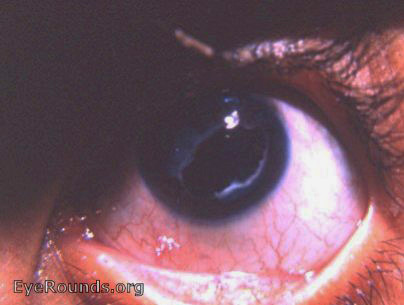EyeRounds Online Atlas of Ophthalmology
Contributor: William Charles Caccamise, Sr, MD, Retired Clinical Assistant Professor of Ophthalmology, University of Rochester School of Medicine and Dentistry
*Dr. Caccamise has very generously shared his images of patients taken while operating during the "eye season" in rural India as well as those from his private practice during the 1960's and 1970's. Many of his images are significant for their historical perspective and for techniques and conditions seen in settings in undeveloped areas.
Category: Cataract
Extracapsular cataract in a child: the use of the Fuchs' syringe

Intracapsular cataract surgery was limited to adults. The reason was the existence of a capsulohyaloid ligament (hyalocapsular ligament: attachment of the vitreous body to the posterior surface of the lens of the eye). This is an important fact to know. It is this ligament that eliminated children from the pool of intracapsular candidates and placed them automatically in the extracapsular group or the needling/discission group. In the attempt to free the lens from this attachment, vitreous would invariably be lost. The patient whose eye is in the photo was a young Indian girl. A Fuchs' two way syringe with an attached canula was used in performing an extracapsular extraction of the child's lamellar cataract. The result was excellent with a large clear opening. The Fuchs' syringe failed to gain any significant popularity in the USA. The photo was taken in 1966 - the year of the operation.

Ophthalmic Atlas Images by EyeRounds.org, The University of Iowa are licensed under a Creative Commons Attribution-NonCommercial-NoDerivs 3.0 Unported License.


